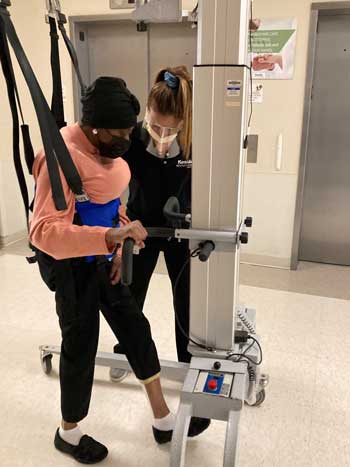The Heart of Gait Training

Rehabilitation assisting a patient with high
intensity gait training. Photo used by permission
of Kessler Institute for Rehabilitation
High intensity gait training benefits patients with traumatic or non-traumatic brain injury who seek to improve their walking ability
By Shannon Motisi PT, DPT, Board-Certified Clinical Specialist in Neurologic Physical Therapy,
Clinical Specialist-Inpatient Brain Injury Unit, Kessler Institute for Rehabilitation.
Individuals who have sustained a brain injury and are beginning their rehabilitation journey often cite their goal as “to be able to walk again.” The question for rehabilitation specialists is, how do we make this happen? As physical therapists who specialize in neuro recovery, our job is to provide the most effective and efficient evidence-based treatment to help our patients achieve their goals and return home as quickly and safely as possible.
The brain injury rehabilitation team at Kessler Institute for Rehabilitation – West Orange campus has implemented a high intensity gait training program to benefit patients with a traumatic or non-traumatic brain injury, who seek to improve their walking ability.
High intensity gait training (HIGT) is a specialized treatment based on walking practice that is vigorous enough to keep the participant’s heart rate above a certain target level, thereby increasing blood flow and leading to positive changes to the brain. This approach, which relies on greater repetition of walking practice at high intensities, is now a recognized clinical guideline for improving walking function in individuals with stroke and brain injury.
With medical clearance, individuals participate in walking trials designed to keep their heart rate at a target range of 75-85% of their maximum. Heart rate monitors allow the therapy team to continuously gauge the patient’s status. The walking trials are performed over ground (which may also include stairs or other types of elevations) or on a treadmill. In addition, the trials are constantly varied to keep the patient within the target heart rate zone and address the specific areas of walking required to make it successful. This may include walking on an incline, walking backwards, resisted walking, side-stepping, and stepping over obstacles.
Depending on the level of assistance a patient requires, the therapy team will introduce different equipment for HIGT. For example, the use of a body weight support system allows us to treat individuals either over ground or over a treadmill. Various other walking devices may also be used to offer the support needed to reach the high repetition of stepping that this program requires.
This innovative program has proven to be successful in engaging our patients. They are increasingly motivated to attain their target heart rate and look forward to weekly reassessments of balance, and both walking speed and endurance. In turn, this is leading to improved outcomes and helping patients achieve their individual mobility goals.
"It's such hard work, but it has really helped me walk better.
I can see the difference in my walking after doing this intense training."
– HIGT participant
This article is a re-print from the Fall 2021 issue of TBI News & Views
